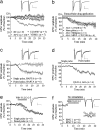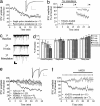Retrograde endocannabinoid signaling at striatal synapses requires a regulated postsynaptic release step
- PMID: 18077376
- PMCID: PMC2154471
- DOI: 10.1073/pnas.0706873104
Retrograde endocannabinoid signaling at striatal synapses requires a regulated postsynaptic release step
Abstract
Endocannabinoids (eCBs) mediate short- and long-term depression of synaptic strength by retrograde transsynaptic signaling. Previous studies have suggested that an eCB mobilization or release step in the postsynaptic neuron is involved in this retrograde signaling. However, it is not known whether this release process occurs automatically upon eCB synthesis or whether it is regulated by other synaptic factors. To address this issue, we loaded postsynaptic striatal medium spiny neurons (MSNs) with the eCBs anandamide (AEA) or 2-arachidonoylglycerol and determined the conditions necessary for presynaptic inhibition. We found that presynaptic depression of glutamatergic excitatory postsynaptic currents (EPSCs) and GABAergic inhibitory postsynaptic currents (IPSCs) induced by postsynaptic eCB loading required a certain level of afferent activation that varied between the different synaptic types. Synaptic depression at excitatory synapses was temperature-dependent and blocked by the eCB membrane transport blockers, VDM11 and UCM707, but did not require activation of metabotropic glutamate receptors, l-calcium channels, nitric oxide, voltage-activated Na(+) channels, or intracellular calcium. Application of the CB(1)R antagonist, AM251, after depression was established, reversed the decrease in EPSC, but not in IPSC, amplitude. Direct activation of the CB(1) receptor by WIN 55,212-2 initiated synaptic depression that was independent of afferent stimulation. These findings indicate that retrograde eCB signaling requires a postsynaptic release step involving a transporter or carrier that is activated by afferent stimulation/synaptic activation.
Conflict of interest statement
The authors declare no conflict of interest.
Figures



References
Publication types
MeSH terms
Substances
Grants and funding
LinkOut - more resources
Full Text Sources
Miscellaneous

